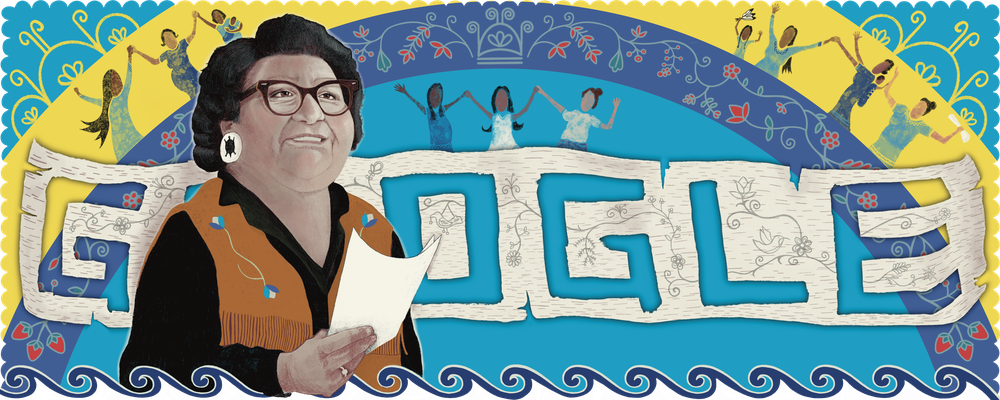Editor’s note: This post is guest-written by Kanien’keháka (Mohawk) filmmaker Courtney Montour. She is the writer and director of “Mary Two-Axe Earley: I Am Indian Again.” Today, the Google Canada homepage Doodle honors Mary Two-Axe Earley, a Kanien’keháka (Mohawk) woman who fought for more than two decades to challenge sex discrimination against First Nations women embedded in Canada’s Indian Act. The Doodle was created by Kanien’keháka (Mohawk) guest artist Star Horn. This post has also been translated into Mohawk.
Mary Two-Axe Earley is a name I grew up always knowing. We are both Kanien’keháka (Mohawk) from Kahnà:wake, located across the river from Montreal, Quebec. I was a teenager when Mary passed away in 1996, too young to fully grasp the impact she had on people’s lives across Canada. I set out to make “Mary Two-Axe Earley: I Am Indian Again” to bring attention to a pivotal figure who is often overlooked in accounts of this country’s history.
Mary fought for more than two decades to challenge sex discrimination against First Nations women in Canada’s Indian Act and became a key figure in Canada’s women’s rights movement. The Indian Act of 1876 defines who is an “Indian” and who can belong to an “Indian band” (now referred to as First Nations). The federal government targeted First Nations women, stripping them of their Indian status (their recognition as an Indian) if they married a non-Indian man. These laws banned First Nations women and their children who lost their status from living in their communities, denying them access to critical social programs and voting rights in their community, and severing their ties to identity and culture. Thousands of First Nations women affected by this legislation are still waiting to be recognized by Canada.

Mary garnered the support of influential political figures and women’s rights activists. She led with love, compassion and persistence, something that I see so many of our women carrying with them as they continue this crucial work for sex equality.

Mary Two-Axe Earley (centre) at the Montreal Botanical Garden tree planting ceremony (mid-1970s). Photo courtesy of Rosemary Two Rivers.
Making “Mary Two-Axe Earley: I Am Indian Again” was a four-year journey that connected me with Mary’s supporters from across the country. I quickly realized that the biggest challenge would be finding audio and visual archives. I was saddened and frustrated to discover that so few images from Mary’s well-documented, more than 20-year fight remained in Canada’s media and archival institutions. This instilled a sense of urgency to bring Mary’s story to the screen for the very first time even more.
Abenaki filmmaker Alanis Obomsawin, who mentored me on my short doc “Flat Rocks,” gifted me audio recordings she taped with Mary over several months in 1984. They were recorded in Mary’s home, around the kitchen table, where Mary’s advocacy began. They are the roots of the documentary, allowing Mary to tell her story in her own words.

Mary Two-Axe Earley with René Lévesque, Premier of Quebec, at the First Ministers’ Conference on Aboriginal Constitutional Matters, Ottawa (1983). Photo courtesy of the National Film Board of Canada.
The film chronicles some of the results of Mary’s work. On June 28, 1985, nearly two decades after Mary began her fight against sex discrimination in the Indian Act, the Parliament of Canada passed Bill C-31, an amendment to restore Indian status to women who had lost it through marriage. The Bill was effective April 17, 1985. And the movement for sex equality continues today: The Final Report of the National Inquiry into Missing and Murdered Indigenous Women and Girls (MMIWG) cited sex discrimination in the Indian Act as a root cause of violence and discrimination faced by First Nations women in Canada.
As National Indigenous History Month in Canada draws to a close, Canadians and Indigenous communities are grappling with Canada’s failure to properly acknowledge the historical and ongoing genocide of Indigenous Peoples in this country. At the end of May, the Tk’emlúps te Secwépemc First Nation found the remains of 215 children who had been buried in unmarked graves at the site of a former Indian residential school in British Columbia. And searches are being done at other former residential schools. A week later, the Government of Canada released the long-awaited National Action Plan to end violence against Indigenous women and girls. Critics say the government’s plan lacks tangible goals, a detailed timeframe and budget.
I’m reminded of a moment in the film when Mary reflects on the first time she spoke out, at the 1968 Royal Commission on the Status of Women in Ottawa. She worried about the consequences of doing so — of potentially being forced to leave her home and her community. But Mary pushed ahead. She secretly organized and hid on a bus full of women to travel to the Royal Commission. Mary was leading a movement. “In ’68, nobody dare say anything against the Indian Act,” said Mary.
Today we honor the legacy of Mary Two-Axe Earley and all the women who continue to demand sex equality for First Nations women and their children. Her work still has an impact on our lives today, inspiring us to speak out against these injustices and to collectively uplift First Nations women. Mary shows us that our history matters, our women matter and our families matter.
“Mary Two-Axe Earley: I Am Indian Again” is produced and distributed by the National Film Board of Canada and is currently screening on the film festival circuit. In December 2021, the film will be available for educators and teachers via CAMPUS, as well as for community screenings across Canada and will be launched on NFB.ca/ONF.ca for free streaming across Canada in June 2022. Watch the trailer now on the National Film Board of Canada’s website, where you can also find more information on CAMPUS. To book a community screening, please contact Donna Cowan at d.cowan@nfb.ca.
Òn:wa wenhniserá:te’ Kanien’kehá:ka karáhstha’ Star Horn ioráhston ne Koráhne aó:wen Google Doodle. Wa’tiakononhwerá:ton’ ki’ ne Mary Two-Axe Earley. Ehtà:ke tiakoká:raton ne Courtney Montour, Kanien’kehá:ka Teióia’ks Iakón:nis. “Mary Two-Axe Earley: Skonkwehón:we Á:re” iakohiá:ton tánon’ tiakoniarotáhrhon.
Shontonkwatehiahróntie’ shikhehsennaienté:ri ne Mary Two-Axe Earley. Teiakenitsá:ron Kanien’kehá:ka na’teiakeniia’tò:ten’ tánon’ Kahnawà:ke iontiatehià:ron, ísi’ na’kaniatará:ti Tiohtià:ke tkaná:taien. Tióhton iawén:re tewen’niáwe tánon’ tióhton niwáhsen ià:ia’k shiiohseratátie’ sha’ontóhetste’ ne Mary, tánon’ nì:’i shitià:tase’. Iah ki’ ní: thiewákhe’ tó: niió:re’ tsi ionkhiia’takéhnhen ne Koráhne. Né: ká:ti’ wa’katerihwahténtia’te’ ákhsa’ kí:ken teióia’ks “Mary Two-Axe Earley: Skonkwehón:we Á:re”. Wà:kehrek aonsakerihó:wanahte’ tsi niiehsennowá:nen, nè:’e tsi iotkà:te’ enhon’nikonhrón:ni’ tsi iah thahatiká:raton’ tsi niiakoié:ren nó:nen enhatiká:raton’ tsi nitiawénhseron ne Koráhne.
Skáhere’ ne tewáhsen niiohserá:ke ieiakorihwà:re’ ne takaténionke’ ne Indian Act kaianerénhsera’ né: tsi kà:ron nitionáttehkwe’ ne konnón:kwe tsi ní:ioht ne ronnón:kwe ne kaianerenhserá:kon. Tho ki’ nontá:we’ tsi wa’éhente’ ne Koráhne tsi kontirihwáia’ks ne konnón:kwe aotiianerenhsera’shòn:’a aorihwà:ke. Indian Act sha’té:kon iawén:re tewen’niáwe tánon’ tsá:ta niwáhsen ià:ia’k nikaianerenhserò:ten’ tewanónhtons ónhka onkwehón:we enkénhake’ (indian iontatena’tónhkwen) tánon’ ónhka enwá:ton’ eniontià:taren’ ne onkwehón:we raotinakerahserá:kon (Indian Band rotina’tónhkwen). Kakoráhsera’ wahshakotiia’tará:ko’ ne konnonkwehón:we ne ahshakotiianerenhseráhkhwa’ tóka’ ahotiniákonke’ ne iah tehonnonkwehón:we. Kaianerénhsera’ wa’akóhnhe’se’ ne konwatiianerenhseráhkhwen konnonkwehón:we tánon’ akotiien’okòn:’a ne raonatená:takon ahatinákereke’, ahotiia’takehnhahtsheraientà:seronke’ tánon’ ne akontatshennarà:na’ tsi tehonnitiohkwakénnie’s. Wa’akó:ia’khse’ tsi nahò:ten’ ionatstáhkwen ne konnonkwehón:we akontatena’tónhkhwake’, tánon’ wa’akóhkhwa’ tsi niiotirihò:ten’. Tewen’niawe’ékhon tsi nikón:ti ne konnonkwehón:we shé:kon kaianerénhsera’ kahsnonhsó:kon tkontiia’tò:ron tánon’ iotihrhá:re’ ne aonsahshakotiianerenhserawíhon’ ne Kakoráhsera’.
É:so iá:kon ne iekó:ra tánon’ ierihwáia’ks ne konnón:kwe aotirihwà:ke wa’tkonwatihswanéta’ ne Mary. Akwáhs kanoronhkhwahtsherá:kon, atennitenrahtsherá:kon tánon’ atkontahkwahtsherá:kon ienenhrí:neskwe’. É:so kón:ti ne konnón:kwe khé:kens ne tho sha’teiotiierenhátie’ tsi iotiio’tátie’ ne kaianerenhserá:kon sha’taonsahonátteke’ ne konnón:kwe tánon’ ronnón:kwe.
Kaié:ri niiohserá:ke wakón:ni’ ne “Mary Two Axe-Earley: Skonkwehón:we Á:re”. Kwah shikón:ni é:so iá:kon ne tekonwatihswanéten ne Mary wa’tiakwatatientéhrha’ne’. Kanakerahserakwé:kon nitiakawenónhseron. Óksa’k wa’kattokáhstsi’ tsi né: aonhà:’a entewakentó:ra’se’ ne thé:nen iakowennáten tóka’ ni’ ieia’tarónnion aketshenrión:ko’ tsi iontahkwenniaientahkhwa’kó:wa. Onke’nikonhraksà:ten’ tánon’ onkena’kón:ni’ tsi iah é:so tetká:ien ne Mary ieia’tarónnion ne Koráhne tsi iontahkwenniaientahkhwa’kó:wa’s ne tká:ra’s tánon’ ón:kwe ieia’tarónnion. Arohátien tsi kwah tewáhsen niiohserá:ke shakotíhseron tánon’ shakoti’nikonhrarátie’skwe’. Thó:ner ki’ é:so tsi wa’tewakhsteríha’te’ ne aontontié:renhte’ taióia’ke’ ne Mary akoká:ra’.
Abenaki ionkwehón:we Alanis Obomsawin tetewakerihwahsnie’séhahkwe’ shikón:ni ne “Flat Rocks” teióia’ks. Aónha ki’ ón:kon’ ne Mary iakowennatárion, né: ne tióhton iawén:re tewen’niáwe tánon’ sha’té:kon niwáhsen kaié:ri shiiohseratátie’ wa’akowennáta’ tsi iakoká:raton. Mary tsi tiakonónhsote’ tsi iekhonnià:tha’ atekhwahrahtsherákta iotiwennáten, tsi ki’ kwah nón:we Mary taiontáhsawen’ aierihwaia’ákhseke’. Ohtehra’shòn:’a ne thí:ken akokara’shòn:’a, ón:ton’ aionkhikaratón:hahse’ ne Mary teióia’ks nón:we.
Teióia’ks oh niioieránion ne Mary akoio’ténhsera’. Tewáhsen niiohserá:ke iakorihwáien, ieiakorihwà:re’ ne sha’taonsahonátteke’ ne ronnón:kwe tánon’ konnón:kwe áse’ken Indian Act iakokèn:ron ne konnonkwehón:we. Sok ki’ Ohiarí:ha tewáhsen sha’té:kon shiská:rahkwe’ tióhton iawén:re tewen’niáwe tánon’ sha’té:kon niwáhsen wísk shiiohserá:te’ Kakoráhsera’ wahatiianerenhseróhetste’ ne’ Kaianerénhsera’ Aón:ton C-31 (Bill C-31). Iehotiiéhston tehotiténion ne kaianerénhsera’, són:ton’ ne konnonkwehón:we iotiniá:kon tóka’ ni’ iotiniakòn:ne aonsaiotiianerenhseraientà:seron’. Shé:kon ki’ nòn:wa wenhniseraténion iotiianerenhserahskéhnhen ne konnón:kwe sha’taonsahonátteke’ tsi ní:ioht ne ronnón:kwe. Kentióhkwa ne rotirihwisá:kon tánon’ rotiri’wanón:ton ne kanakerahserakwé:kon oh niiawèn:’en tsi konwatiia’taié:was tánon’ konwanahsehtánion ne konnonkwehón:we tánon’ kontiksa’okòn:’a, kí:ken kentióhkwa ohna’kénhaton rotihiá:ton tsi rotirihwatshénrion tsi Indian Act tiorihón:ni tsi konwatikarewahtánions tánon’ konwatikenhren’seronniánions ne konnonkwehón:we ne Koráhne nón:we.
Tsi ó:nen iotenhni’to’kta’onhátie’ ne Onkwehón:we Akawenhnì:ta’ ne Koráhne, Korahró:non tánon’ Onkwehón:we shé:kon tehonatatiénhton ne aonsahontate’nikonhrahserón:ni’ áse’ken Kakoráhsera’ iah orihwí:io tha’tehatirihwa’serákwas oh nihotiieránion tsi niiohseré:son’s tánon’ né: ó:ni’ tsi thahón:nehre’ ahshakonáhton’te’ nonkwehón:we nok ahatirihwahtòn:thake’ ne onkwehón:we tsi nihotirihò:ten’s. Tsi ontenhni’tò:kten’ ne Onerahtohkó:wa, tsi Tsonontati’kó:wa (British Columbia) nón:we, tsi rontientáhkhwahkwe’ ne ronnonkwehón:we ratiksa’okòn:’a, Tk’emlúps te Secwépemc onkwehón:we sahatihstien’tatshenrión:ko’ ne tékeni tewen’niáwe tánon’ wísk iawén:re nihá:ti ratiksa’okòn:’a thatiia’tatárion, iah tekentstenhró:ton. Sok ki’ tsahià:khsera ohnà:ken, Kakoráhsera’ tahónhtka’we’ ne kanonión:ni ne oh nenkaié:ren ne tóhsa akonwatikarewahtaniónhseke’ ne konnonkwehón:we tánon’ kontiksa’okòn:’a. Tsi niiá:kon ne iakohiatonhseraka’én:ion nahò:ten thonahtkà:wen ión:ton tsi iah thiekaié:ri tsi ní:ioht tsi karihwahseronniánion ne ahatirihwaié:rite’, kátke eh tho nenkaieránionke’ tánon’ ka’ néntewe’ ne ohwísta’.
Nè:’e ki’ sonkwehiahráhkwen’ tsi wa’eká:raton’ ne Mary néne tiotierénhton sha’onthró:ri’ nahò:ten tiakawehtáhkwen tánon’ iah teierihwanòn:we’skwe’, tióhton iawén:re tewen’niáwe tánon’ ià:ia’k niwáhsen sha’té:kon shiiohserá:te’ nen’ nè:’e ne Royal Commission ne Kanà:tso nonkwá:ti. Teiako’nikonhrhá:rahkwe’ oh naiakoia’tawèn: enke’ tóka’ aiakotatì:’on áse’ken wate’shennaién:tahkwe’ ne ahshakotinakerakwáhtonke’ tsi tiakotená:taien. Nek tsi sénha’k ia’ontáthreke’. Karihwahsehtòn:ke iakoterihwahseronníhne ne skátne konnonkwehón:we iakoia’takarénie’s akontíta’ tánon’ akontáhsehte’ oh naiá:wen’ne’ ne Royal Commission nón:we iakón:newe’. Iakonenhrí:nonhkwe’ ne Mary. Iaká:wen, “Né: ne tióhton iawén:re tewen’niáwe tánon’ ià:ia’k niwáhsen sha’té:kon shiiohserátie’, iah ónhka teiakote’nientèn:’en ne aierihwáia’ke’ ne Indian Act.”
Òn:wa wenhniserá:te’ wa’tiethinonhwerá:ton’ ne Mary Two-Axe Earley tánon’ akwé:kon tsi nikón:ti ne konnón:kwe shé:kon iotiianerenhserahskéhnhen ne sha’taonsahonátteke’ ne konnonkwehón:we tánon’ akotiien’okòn:’a raotirihwà:ke. Shé:kon ne òn:wa wenhniseraténion ionkwaia’takehnhenhátie’ ne tsi ní:kon iakoio’tèn:’en. Shé:kon ieionkhi’nikonhrà:reks ne aietewarihwaia’ákhseke’ kí:ken nahò:ten’ iah tekarihwakwaríhsion, tánon’ ne enskátne aiethi’nikonhrakará:tate’ ne konnonkwehón:we. Mary ionkhina’tón:ni tsi káhsta ne onkwakara’shòn:’a tsi nitiawénhseron, kontiia’tanó:ron ne konnonkwehón:we tánon’ onkwahwatsire’shòn:’a.






